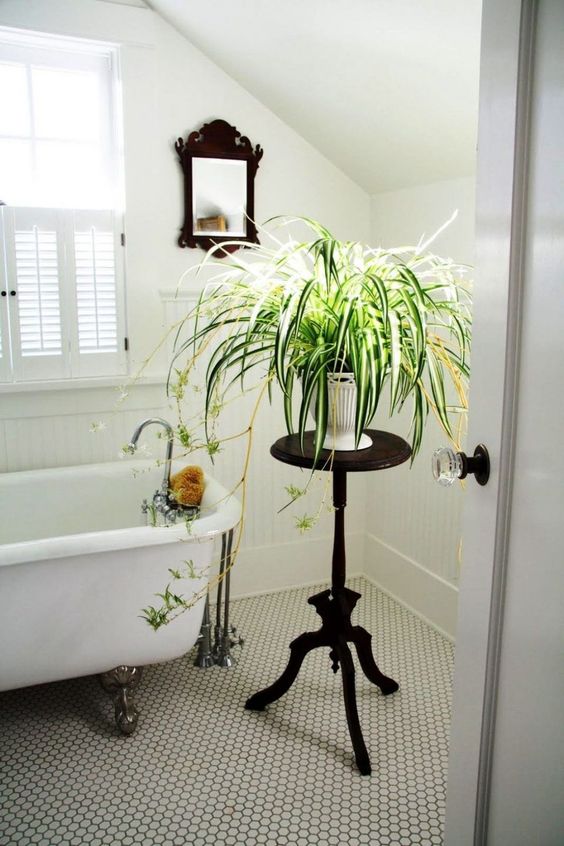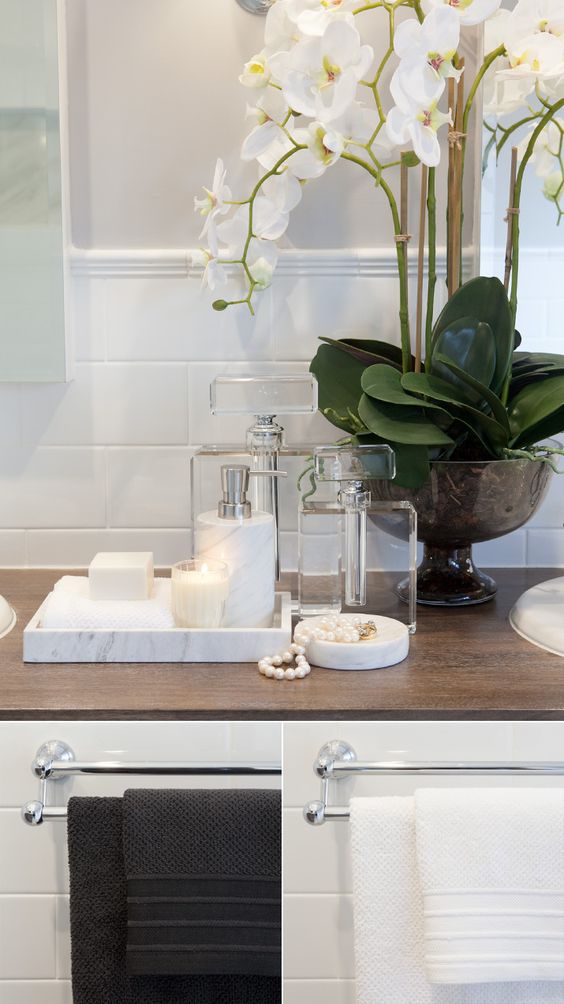Finding the right plants for your home sometimes requires considering different environmental conditions. The bathroom is often a space with a special atmosphere. High humidity and low light levels provide an ideal growing environment for certain plants. If you’re looking to add some greenery to your bathroom, here are ten plants that seem to be the most suitable and best suited to thrive in such an environment.

image from Follow The Yellow Brick Home
This plant is praised for its excellent air purification effects, and its leaf surface can effectively absorb harmful substances in the air, such as formaldehyde and volatile organic compounds such as benzene. Its distinctive characteristics of growing under different conditions demonstrate its excellent adaptability. The bathroom, as a humid environment, is not difficult for this plant to adapt to, but may provide it with ideal growing conditions. Moist air may help maintain the vitality and vitality of its leaves, thereby better performing its role in purifying the air. The vigorous growth of this plant not only adds a touch of greenery to the bathroom, but also provides a fresher and healthier atmosphere to the indoor environment.
Sansevieria Trifasciata

image from WordPress.com
This plant variety is widely recognized as a model of shade and drought tolerance, and its leaves show adaptability to light. Its leaf structure and physiological characteristics enable it to efficiently utilize weak light sources in the environment for photosynthesis, so it can maintain its growth vitality even in bathroom environments with relatively dark light. In addition, its root system has excellent water storage capacity and can meet the water needs of the plant for a longer period of time. This property allows it to survive and thrive in environments like bathrooms. In addition, its air purification capabilities are even more impressive. The special surface structure of its blades is conducive to capturing dust and harmful gases in the air, thereby improving indoor air quality. Therefore, this plant not only serves as a decoration in the bathroom, but also acts as a functional air purifier
Epipremnum Aureum

image from HOME DESIGNERs DECORHOLICs
This type of plant has excellent photosynthetic adaptability, and the structure and physiological mechanism of its leaves enable it to flexibly adjust its ability to adapt to different light conditions. This adaptive trait allows them to maintain normal growth and development in relatively low-light environments. Environments like bathrooms often have weak light, but these plants can still achieve basic nutrient synthesis by relying on their efficient photosynthesis mechanism.
In addition, these plants are usually very adaptable to humidity. They can effectively regulate water absorption and transpiration in high-humidity environments, maintaining the water balance on the leaf surface, thus ensuring their normal growth. For this plant, the high humidity environment in the bathroom is not a problem, but helps it grow and provides a more suitable growing environment. Therefore, both their flexible adaptability to light conditions and their good adaptability to humidity environments make this type of plant an ideal choice for thriving in bathrooms.
Ferns

image from Gardenista
Ferns such as Boston fern and maidenhair fern are remarkably adaptable to high humidity and lower light conditions, making them ideal bathroom plant choices. The surface of fern leaves is covered with fine hair-like structures, which help capture moisture in the air and promote water transpiration in the plant, helping to maintain the water balance on the leaf surface in high-humidity environments. This property allows ferns to thrive in humid environments such as bathrooms.
Dracaena Sanderiana

image from pingsf
Lucky bamboo (Dracaena sanderiana), commonly known as “water bamboo”, is known for its special ability to grow in water. This plant is usually cultivated in water as an ornamental plant. Its stems and roots form a good growth state in the water, which is one of the reasons why it is widely used in hydroponic systems. The growth of lucky bamboo does not strictly require sufficient light, because its leaves have the characteristics of adapting to low-light environments and can maximize the use of residual light sources in the environment for photosynthesis. Therefore, Lucky Bamboo can keep growing even in low light conditions. Moreover, lucky bamboo also shows strong adaptability to high-humidity environments. The aquatic growth state formed by its roots in the water allows the plant to fully absorb water and nutrients, while also helping to maintain the water balance on the leaf surface. Therefore, high-humidity environments such as bathrooms are very suitable places for lucky bamboo to grow.
Zamioculcas Zamiifolia

image from Plantje.nl
This plant is prized for its exceptional durability, with unique growth characteristics that allow it to survive and thrive in extreme conditions. Regarding light conditions, it is able to adapt to lower light environments. This is due to the physiological structure of its leaves and photosynthetic adaptability, and it can still perform basic nutrient synthesis in the presence of insufficient light. This also makes this plant one of the best plants to place in areas with low light, such as bathrooms.
Orchids

image from Alfresco Emporium
If you’ve ever seen those elegant bathrooms with colorful, blooming orchids as the focal point, it’s no surprise that these plants are a top choice among interior designers. With their graceful flowers, rich colors and unique shapes, these orchids occupy a unique and eye-catching place in interior design. More than just beautiful decorative elements, they are considered perfect to enhance the ambience of a bathroom space, giving it a more vibrant and sophisticated feel.
They require just the right amount of humidity to grow, which makes humid spaces like bathrooms a breeding ground for them to thrive. For orchids, the right amount of moisture is very critical, so indirect light and moderate watering are one of the important conditions to maintain their healthy growth. Orchids don’t need direct sunlight, and excessive light can damage their leaves. They prefer soft, indirect light, such as being placed in a bright location indoors but not in direct contact with sunlight. Additionally, orchids do not require frequent watering, and excess water may cause their roots to rot. Generally, after each watering, wait until the soil surface is slightly dry before watering the next time to ensure that the orchid’s growing environment remains moderately moist but not too wet. Careful orchid care will allow your orchid to thrive in an environment like your bathroom and continue to produce stunning flowers.
Calathea spp.

image from Two Peas in a Condo
Calathea is notable for its striking leaf pattern and preference for high humidity. This type of plant usually has gorgeous and attractive foliage, and its patterns and colors create a visual artistic effect and are the highlight of interior decoration. The photosynthetic adaptability of its leaves can make full use of a small amount of light and can maintain normal growth even in an environment with insufficient light. Additionally, they like to grow in moist environments, and their preference for high humidity makes bathrooms an ideal environment for their growth. In high-humidity conditions, these plants maintain the water balance of their leaves and display more colorful, healthy leaves.
Aloe Vera

image from Apartment Therapy
Aloe Vera, as a succulent, usually prefers bright, indirect light. However, aloe vera thrives equally well in a bathroom environment with moderate light levels. Although it may be sensitive to excessive sunlight, good growing conditions can be provided in locations such as bathrooms by ensuring that direct sunlight is avoided. It is worth mentioning that aloe vera has relatively low light requirements, which also allows it to adapt to a variety of lighting conditions in indoor environments. In a bathroom environment with moderate lighting, aloe vera can maintain its green and succulent state while also accumulating needed nutrients.
Philodendron

image from Soonafternoon
Philodendron and other similar species exhibit excellent adaptability to the changes in light and humidity found in the bathroom environment, allowing them to thrive in this environment. These plants are often remarkably resilient and adaptable to relatively low light levels and frequently changing humidity conditions.
Their growth habit allows them to obtain the water and nutrients they need from the environment and perform basic photosynthesis in lower light conditions. This adaptability allows them to not only thrive in areas with low light, such as bathrooms, but also to effectively cope with humid environments and maintain the moisture balance on the leaf surface. These plants are generally durable and not overly sensitive to humidity fluctuations and lack of light, which makes them ideal for bathrooms.
Whether it’s to improve air quality, add the beauty of greenery, or simply make your bathroom more comfortable, choosing the right plants is crucial. These ten plants not only bring a refreshing atmosphere, but also demonstrate their adaptability and tenacity, making your bathroom the ideal place for them to thrive. May these green companions add vitality to your space and bring joy and tranquility.